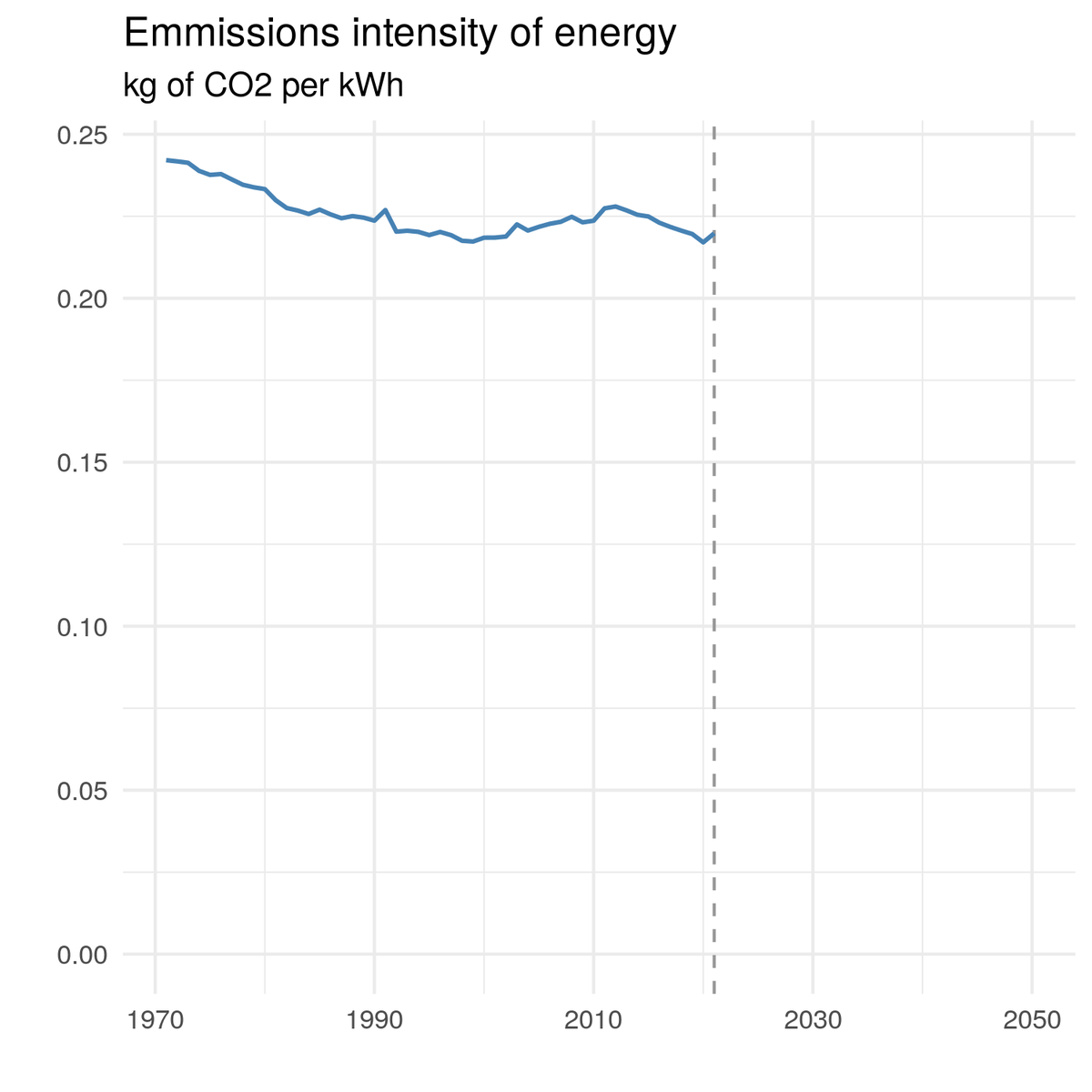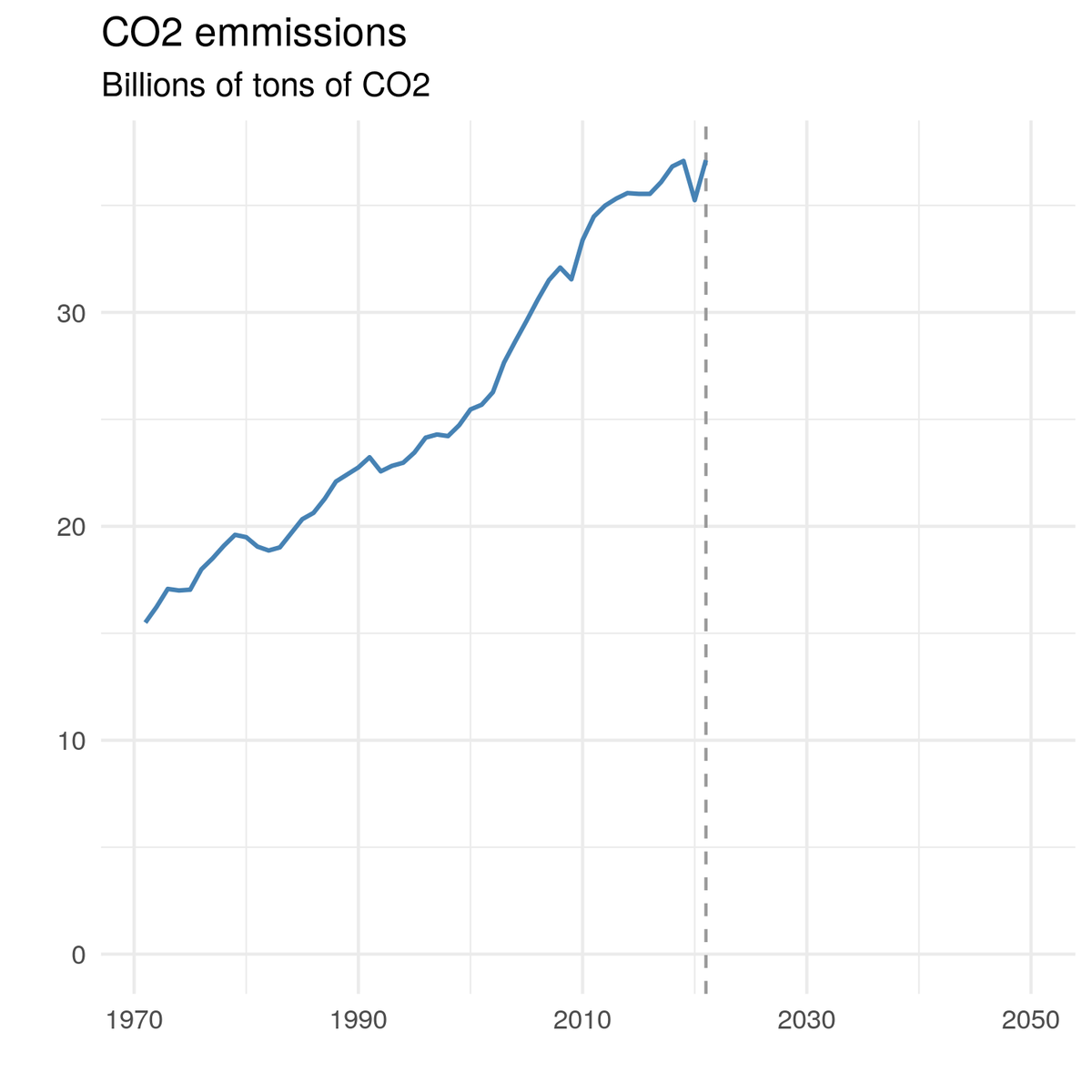Preberite spodnjo nit Joja Michella, ki bo jeseni izšla v obliki znanstvenega članka v EJEEP. Michell je naredil dekompozicijo izpustov CO2 na glavne komponente (prebivalstvo, BDP/prebivalca, energetsko intenzivnost BDP in intenzivnost emisij v proizvodnji energije) in simuliral, kako realističen je scenarij razogljičenja. Ugotavlja, da če hočemo do leta 2050 zmanjšati emisije CO2 blizu ničle, bi ob nadaljevanju sedanjih trendov glede energetske intenzivnosti in intenzivnosti emisij morali zmanjšati življenjski standard (BDP na prebivalca) na svetu za več kot 40% (popolna odrast), kar je seveda absolutno nerealistično. Če hočemo obdržati življenjski standard in ga normalno povečevati (rast BDP/preb po 1.5% letno), bi ob trendnih tehničnih predpostavkah glede energetske intenzivnosti in intenzivnosti emisij morali cilj glede razogljičenja prepoloviti.
Smo torej pred dilemo nižji standard ali manj ambicioznosti glede razogljičenja? Ne nujno. Odgovor se skriva v intenzivnosti emisij na enoto energije. Glede slednje namreč dosedanje politike v razvitih državah (zamenjava premoga pri proizvodnji električne energije z OVE vetra in sonca) ne dajejo in ne morejo dati ustreznih rezultatov. Kajti prehod iz premoga na OVE vetra in sonca (zaradi variabilne narave delovanja sončnih in vetrnih elektrarn ter potrebe po nadomestnih kapacitetah) pomeni dejansko prehod iz premoga na plin, kar pomeni zgolj tretjinsko razogljičenje proizvodnje električne energije. Če pa bi električno energijo iz premoga in plina zamenjali z jedrsko in hidro energijo, bi se izpusti CO2 zmanjšali za do 95% (glede na premog). Če torej resno mislimo z razogljičenjem, tega s soncem in vetrom ne moremo doseči, ampak moramo poseči po bolj zanesljivih virih energije.
___________
When I started thinking about the relationship between growth, technology and emissions, I quickly came across the widely used Kaya identity.
This decomposes emissions into a number of key indicators and ratios: population, GDP per capita, energy per unit of GDP and emissions per unit of energy.
I found it surprisingly difficult to find clear decompositions of the historical data and forecasts and scenarios using the identity — perhaps I didn’t look hard enough. Anyway, I decided to have a go myself.
1. Population. Currently around 8bn, projected by the UN to increase to a bit short of 10bn by 2050
2. Global GDP per capita. Cross country comparisons are fraught with problems, but as a first approximation, it was around $11K 2015 USD in 2021.
Let’s hold off on the projections on the rest of the variables for now.
3. Energy per unit of GDP. Declined steadily in what looks like a pretty linear trend from about 3.50kWh per $ to about 2kWh.
4. Emissions per unit of energy. Between 1970 and 1990 it came down a bit. Since 1990, it’s been fairly flat at about 225g of CO2 per kWh
5. Emissions. Steady increase, a dip during the pandemic followed by the most recent reading of an all time high in 2021.
The Kaya identity tells that for emissions to reach zero, one or more of these components must hit zero (or at least get down to the low levels at which gross emissions can be fully offset by carbon capture, if we taken an optimistic view of this technology).
The only one of these series which could plausibly get to zero is emissions per unit of energy. If we simply extrapolate from past trend, this looks unlikely — it’s been flat for 30 years.
What do we expect these series to do in the future? We’ll take the UN projections as a baseline and focus on the other variables.
Imposing degrowth trends for energy/GDP and emissions/energy from IEA-IRENA (2017) 66% 2C projections, described at the time as “highly optimistic”, and rapid reductions in carbon emissions to around 4bn tons implies the resulting entirely implausible path for GDP per capita.
Alternatively, if we assume continued GDP per capita growth of 1.5% plus somewhat less optimistic emissions/energy trends, the implication is carbon emissions which likely generate heating in excess of 2C.
Here are the two scenarios shown on the same axes.
(Both use the same trend assumptions for energy/GDP so it’s labelled ‘baseline’).I think that everything hinges on emissions intensity of energy. Unless there is a dramatic and rapid change in trajectory of this ratio, the remaining carbon budget will be used up sooner rather than later. This is the core of the debate between optimists and pessimists.
What is clear is that almost all ‘decoupling’ that has occurred so far has not been the result of reduced emissions intensity of energy production, but from reduced energy intensity of economic activity.
How plausible is the required change in trajectory? Optimists point to trend adoption of new tech such as solar, pessimists point to past trends and the fact that solar installation is only part of the job and things like housing retrofitting (and ULEZ zones) are more difficult.
The future trajectory is highly uncertain. However, the costs are not equally weighted. The risks associated with excess optimism are, in my view, substantially higher than those associated with excess pessimism.
That’s why I think we need to treat touted tech-finance market solutions with scepticism and push for much stronger policy activism which targets all of these ratios, potentially including economic activity, at least in scope if not scale. Ban private jets, for example.
Vir: Jo Michell, twitter










Znanost nima enotnega mnenja, ko gre za razogljičenje. Obstaja mnogo vrhunskih znanstvenikov, ki se s tem ne strinjajo.
Težava pa je v tem, da v medijih slišimo samo eno stran, in sicer tisto, ki zagovarja potrebo po razogljičenju.
2018 je Greta Thunberg napovedala, da bodo klimatske spremembe v 5 letih izbrisale človeštvo iz površja zemlje, če ne bomo nehali kuriti nafte. Greta navaja profesorja atmosferske kemije iz Harvarda, Jamesa Andersona.
Po 5 letih smo vsi še tu, članek Andersona pa so izbrisali, in tudi Gretine izjave ni več najti..
Všeč mi jeVšeč mi je
Tule je potreben fact check:
1. Nisem fan Grete in ne razumem, zakaj to mladinko brez kakršnihkoli referenc tako visoko vrednotijo, vendar pa menim, da njeno izjavo narobe interepretirajo. Jaz razumem njeno izjavo (https://twitter.com/BjornLomborg/status/1637916406141394944/photo/1) tako:
da bodo klimatske spremembe izbrisale človeštvo, če v petih letih ne prenehamo uporabljati fosilnih goriv (pri čimer se najbrž sklicuje na Jamesa Andersona), ne pa, da bodo klimatske spremembe izbrisale človeštvo v petih letih.
V slovenščini bi bilo to lažje razumljivo in manj podvrženo napačnim interepretacijam, ker bi morali paziti, kako so postavljene vejice (seveda ob predpostavki, da pišoči obvlada slovnico)
2. James Anderson: Ne poznam njegovega članka, vendar to, kar je povedal za Forbes (https://www.forbes.com/sites/jeffmcmahon/2018/01/15/carbon-pollution-has-shoved-the-climate-backward-at-least-12-million-years-harvard-scientist-says/?sh=374eb2bf963e) makes sense to me. Pravi, da izginotje permanentnega ledu na obeh polih, s čimer se skorajda izenačijo temperature na polih s tistimi na ekvatorju, vodi v močno povišanje izparevanja, kar je gorivo za formiranje velikih neviht. Nekaj, kar lahko opazujemo danes, ko se je Atlantik drastično segrel glede na dolgoletna povprečja (glej: https://twitter.com/LeonSimons8/status/1672992350371446786) in ko imamo v Evropi opravka z velikimi neurji. Ne vem, če obstaja dokazana vzročnost med obema pojavoma (to morajo povedati znanstveniki s teh področij), vendar se zdi smiselno. Anderson:
“The level of carbon now in the atmosphere hasn’t been seen in 12 million years, a Harvard scientist said in Chicago Thursday, and this pollution is rapidly pushing the climate back to its state in the Eocene Epoch, more than 33 million years ago, when there was no ice on either pole.
“We have exquisite information about what that state is, because we have a paleo record going back millions of years, when the earth had no ice at either pole. There was almost no temperature difference between the equator and the pole,” said James Anderson, a Harvard University professor of atmospheric chemistry best known for establishing that chlorofluorocarbons were damaging the Ozone Layer.
“The ocean was running almost 10ºC warmer all the way to the bottom than it is today,” Anderson said of this once-and-future climate, “and the amount of water vapor in the atmosphere would have meant that storm systems would be violent in the extreme, because water vapor, which is an exponential function of water temperature, is the gasoline that fuels the frequency and intensity of storm systems.
People have the misapprehension that we can recover from this state just by reducing carbon emissions, Anderson said in an appearance at the University of Chicago. Recovery is all but impossible, he argued, without a World War II-style transformation of industry—an acceleration of the effort to halt carbon pollution and remove it from the atmosphere, and a new effort to reflect sunlight away from the earth’s poles.
This has to be done, Anderson added, within the next five years.
“The chance that there will be any permanent ice left in the Arctic after 2022 is essentially zero,” Anderson said, with 75 to 80 percent of permanent ice having melted already in the last 35 years.
“Can we lose 75-80 percent of permanent ice and recover? The answer is no.”
The answer is no in part because of what scientists call feedbacks, some of the ways the earth responds to warming. Among those feedbacks is the release of methane currently trapped in permafrost and under the sea, which will exacerbate warming. Another is the pending collapse of the Greenland ice sheet, which Anderson said will raise sea level by 7 meters (about 23 feet).”
Všeč mi jeVšeč mi je
Greta seveda ni nobena referenca, bolj sodi v rubriko zlorabljenih otrok.
Tisto o izbrisu človeštva v 5 letih pa je bilo mišljeno bolj v ironičnem smislu, saj smo deležni podobnih, nikoli izpolnjenih napovedi, vsaj že kakih 60 let.
Spomnimo se, kolikokrat so napovedali, da bo zmanjkalo nafte.
Geolog K. Hubert je 1956 napovedal, da bo črpanje nafte doživelo višek v sedemdesetih letih, potem pa bo količina načrpane nafte samo še padala. Naftne družbe so s to napovedjo, ki nikoli ni bila znanstveno dokazana, dobile dober izgovor, da so 1973 povišale ceno nafte za 400 odstotkov. Hubert je bil zaposlen pri naftni družbi Royal Dutch Shell, kako priročno. Da bo nafte zmanjkalo, so napovedali še za leto 1995, izgleda pa, da je nafte vedno več.
Nekaj podobnega se dogaja s klimatskimi spremembami.
Avstralski geolog in profesor Ian Plimer dokazuje, da človeštvo proizvede samo 3 odstotke CO2, 97 odstokov pa proizvede narava sama.
Če to drži, potem človeštvo ne more občutno vplivati na klimo in je Andersonovo zagovarjanje deindustrializacije za rešitev planeta bolj politične narave, podobno kot je politične narave zagovarjanje zapiranja nukleark in popoln prehod na obnovljive vire energije.
Norost te politike je bila na tem blogu že večkrat utemeljena.
Ian Plimer je na Wikipediji označen kot razširjevalec dezinformacij, in da zavrača znanstveni konsenz o klimatskih spremembah. Kot da bi znanost napredovala s konsenzi. V slabo mu štejejo tudi to, da kritizira kreacionizem (!)
Velja si ogledati njegovo predavanje na Rumblu.
Še mnogo drugih znanstvenikov, med njimi so Nobelovi nagrajenci, nasprotuje uničenju industrije, energetike in kmetijstva na osnovi nepreverjenih teorij in matematičnih modelov, ki so nastavljeni tako, da služijo političnim ciljem elite. V medijih pa se pojavljajo samo zagovorniki “uradne” teorije, ki se spretno izogibajo javnim debatam z nasprotniki.
Vsemogočna NASA je bila pred kratkim zasačena pri prirejanju grafikonov o segrevanju planeta. En grafikon je prikazoval realne podatke (za znanstvenike), drugi grafikon pa je bil malo nabildan (za ljudstvo, da se mu požene nekaj strahu v kosti..)
V iraški vojni smo dobili “embedded” novinarje, v času covida pa še “embedded” doktorje in klimatologe.
Všeč mi jeVšeč mi je